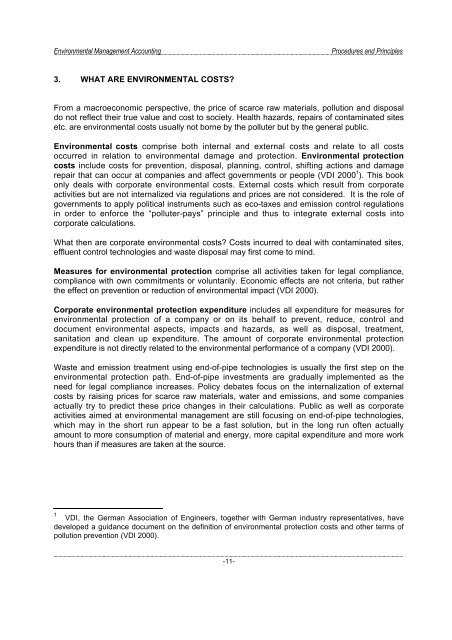Environmental Management Accounting Procedures and Principles
Environmental Management Accounting Procedures and Principles
Environmental Management Accounting Procedures and Principles
Create successful ePaper yourself
Turn your PDF publications into a flip-book with our unique Google optimized e-Paper software.
<strong>Environmental</strong> <strong>Management</strong> <strong>Accounting</strong><br />
<strong>Procedures</strong> <strong>and</strong> <strong>Principles</strong><br />
3. WHAT ARE ENVIRONMENTAL COSTS?<br />
From a macroeconomic perspective, the price of scarce raw materials, pollution <strong>and</strong> disposal<br />
do not reflect their true value <strong>and</strong> cost to society. Health hazards, repairs of contaminated sites<br />
etc. are environmental costs usually not borne by the polluter but by the general public.<br />
<strong>Environmental</strong> costs comprise both internal <strong>and</strong> external costs <strong>and</strong> relate to all costs<br />
occurred in relation to environmental damage <strong>and</strong> protection. <strong>Environmental</strong> protection<br />
costs include costs for prevention, disposal, planning, control, shifting actions <strong>and</strong> damage<br />
repair that can occur at companies <strong>and</strong> affect governments or people (VDI 2000 1 ). This book<br />
only deals with corporate environmental costs. External costs which result from corporate<br />
activities but are not internalized via regulations <strong>and</strong> prices are not considered. It is the role of<br />
governments to apply political instruments such as eco-taxes <strong>and</strong> emission control regulations<br />
in order to enforce the “polluter-pays” principle <strong>and</strong> thus to integrate external costs into<br />
corporate calculations.<br />
What then are corporate environmental costs? Costs incurred to deal with contaminated sites,<br />
effluent control technologies <strong>and</strong> waste disposal may first come to mind.<br />
Measures for environmental protection comprise all activities taken for legal compliance,<br />
compliance with own commitments or voluntarily. Economic effects are not criteria, but rather<br />
the effect on prevention or reduction of environmental impact (VDI 2000).<br />
Corporate environmental protection expenditure includes all expenditure for measures for<br />
environmental protection of a company or on its behalf to prevent, reduce, control <strong>and</strong><br />
document environmental aspects, impacts <strong>and</strong> hazards, as well as disposal, treatment,<br />
sanitation <strong>and</strong> clean up expenditure. The amount of corporate environmental protection<br />
expenditure is not directly related to the environmental performance of a company (VDI 2000).<br />
Waste <strong>and</strong> emission treatment using end-of-pipe technologies is usually the first step on the<br />
environmental protection path. End-of-pipe investments are gradually implemented as the<br />
need for legal compliance increases. Policy debates focus on the internalization of external<br />
costs by raising prices for scarce raw materials, water <strong>and</strong> emissions, <strong>and</strong> some companies<br />
actually try to predict these price changes in their calculations. Public as well as corporate<br />
activities aimed at environmental management are still focusing on end-of-pipe technologies,<br />
which may in the short run appear to be a fast solution, but in the long run often actually<br />
amount to more consumption of material <strong>and</strong> energy, more capital expenditure <strong>and</strong> more work<br />
hours than if measures are taken at the source.<br />
1<br />
VDI, the German Association of Engineers, together with German industry representatives, have<br />
developed a guidance document on the definition of environmental protection costs <strong>and</strong> other terms of<br />
pollution prevention (VDI 2000).<br />
-11-




